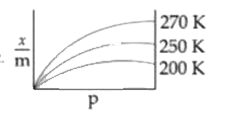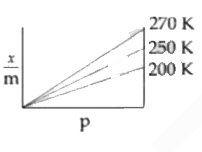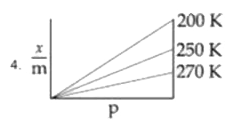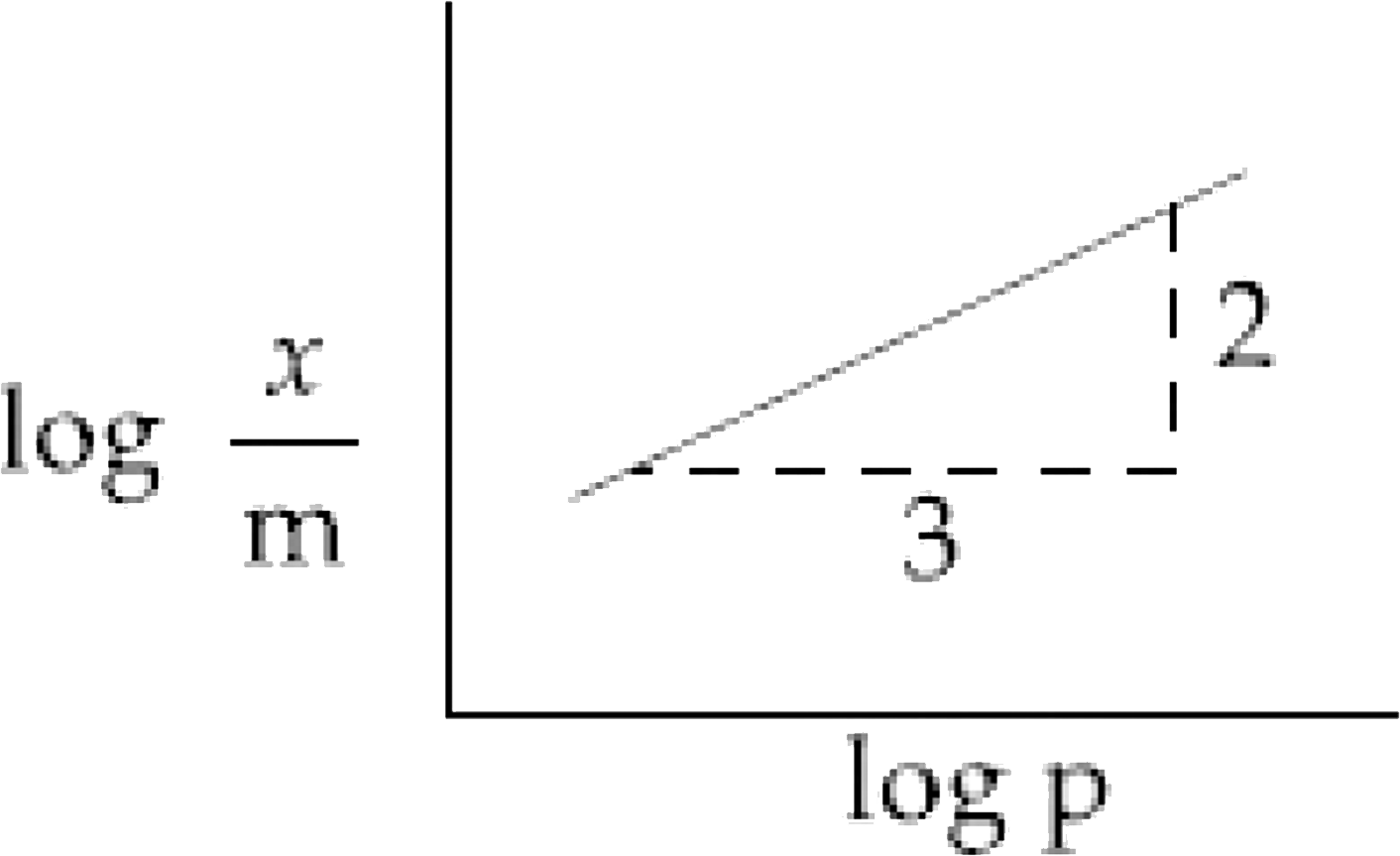Adsorption of gas follows Freundlich adsorption isotherm. If x is the mass of the gas adsorbed on mass m of the adsrobent , the correct plot of xm versus p is :




To solve the problem regarding the adsorption of gas following the Freundlich adsorption isotherm, we need to analyze the relationship between the mass of gas adsorbed per unit mass of adsorbent (x/m) and the pressure (p).
1. Understanding the Freundlich Adsorption Isotherm:
The Freundlich adsorption isotherm is given by the equation:
x/m=k⋅p1/n
where x is the mass of the gas adsorbed, m is the mass of the adsorbent, p is the pressure of the gas, k is a constant, and n is a constant that indicates the adsorption intensity.
2. Analyzing the Equation:
From the equation, we can see that x/m is proportional to p1/n. As the pressure p increases, x/m also increases.
3. Behavior at Different Pressures:
- At low pressures, the adsorption increases rapidly as more gas molecules are available to adsorb onto the surface.
- As the pressure continues to increase, the rate of increase of x/m will start to slow down due to saturation of the adsorbent surface.
- Eventually, at very high pressures, x/m will approach a constant value as the surface becomes saturated and cannot adsorb any more gas.
4. Plotting the Graph:
- The plot of x/m versus p will initially show a steep increase, indicating that as pressure increases, more gas is adsorbed.
- After a certain point, the curve will begin to level off, indicating that the adsorption is reaching saturation.
5. Conclusion:
The correct plot of x/m versus p will show a curve that rises steeply at first and then flattens out as it approaches a constant value. This corresponds to the behavior described by the Freundlich isotherm.
Final Answer:
The correct plot of xm versus p is a curve that increases initially and then levels off.
The Freundlich adsorption isotherm is given by the equation:
x/m=k⋅p1/n
where x is the mass of the gas adsorbed, m is the mass of the adsorbent, p is the pressure of the gas, k is a constant, and n is a constant that indicates the adsorption intensity.
From the equation, we can see that x/m is proportional to p1/n. As the pressure p increases, x/m also increases.
- At low pressures, the adsorption increases rapidly as more gas molecules are available to adsorb onto the surface.
- As the pressure continues to increase, the rate of increase of x/m will start to slow down due to saturation of the adsorbent surface.
- Eventually, at very high pressures, x/m will approach a constant value as the surface becomes saturated and cannot adsorb any more gas.
- The plot of x/m versus p will initially show a steep increase, indicating that as pressure increases, more gas is adsorbed.
- After a certain point, the curve will begin to level off, indicating that the adsorption is reaching saturation.
The correct plot of x/m versus p will show a curve that rises steeply at first and then flattens out as it approaches a constant value. This corresponds to the behavior described by the Freundlich isotherm.
The correct plot of xm versus p is a curve that increases initially and then levels off.
Topper's Solved these Questions
Similar Questions
Adsorptionof a gas follows Freundlich adsorption isotherm. x is the mass of the gas adsorbed on mass m of the adsorbent.
The plot of logxm versus log p is shown in the given graph xm is proportional to :

View SolutionAdsorption of gas follows Freundlich adsorption isotherm. x is the mass of the gas adsorbed on mass m of the adsorbent. The plot of logxm versus log p is shown in the given graph.
xm is proportional to:

View Solution
Knowledge Check
For Freundlich adsorption isotherm, xm=kp1/n , the value of n is
A1. always greater than oneB2. always smaller than oneC3. always equal to oneD4. greater than one at low temperature and smaller than one at high temperature.
Adsorption of a gas follows Freundlich adsorption isotherm. In the given plot,x is the mass of the gas adsorbed on mass m of the adsorbent at pressure P. xm is proportional to:

View SolutionAdsorption of a gas follows Freundlich adsorption isotherm. In the given plot,x is the mass of the gas adsorbed on mass m of the adsorbent at pressure P. xm is proportional to:

View SolutionIf a gas absorbs 200J of heat and expands by 500cm3 against a constant pressure of 2×105Nm−2, then the change in internal energy is
View SolutionFreundlich adsorption isotherm gives a straight line on plotting :
View SolutionAccording to Freundlich adsorption isotherm, which of the following is correct?
View SolutionIn Freundlich adsorption isotherm, adsorption is proportional to pressure P as
View SolutionAdsorption of a gas on a surface follows Freundlich adsorption isotherm. Plot of log xm versus log P gives a straight line with slope equal to 0.5, then :
(xm is the mass of the gas adsorbed per gram of adsorbent)
View Solution
